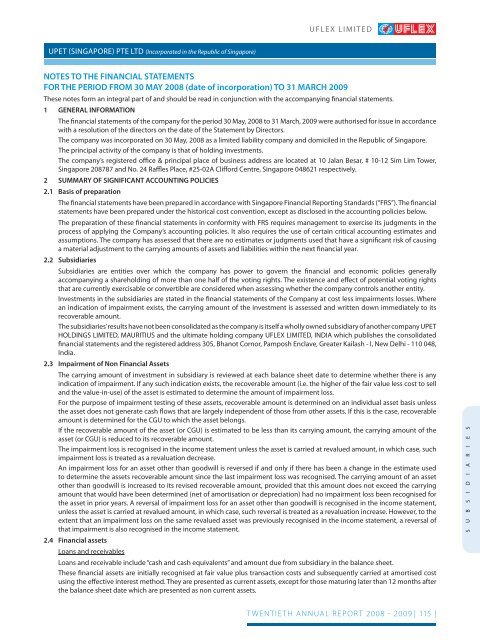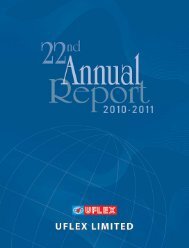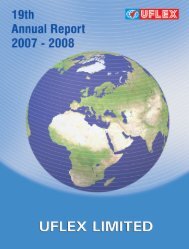Our endeavour is to enhance Stakeholders' Value - Uflex Ltd.
Our endeavour is to enhance Stakeholders' Value - Uflex Ltd.
Our endeavour is to enhance Stakeholders' Value - Uflex Ltd.
Create successful ePaper yourself
Turn your PDF publications into a flip-book with our unique Google optimized e-Paper software.
DIRECTOR’S UPET (SINGAPORE) REPORTPTE<br />
LTD (Incorporated in the Republic of Singapore)<br />
UFLEX LIMITED<br />
NOTES TO THE FINANCIAL STATEMENTS<br />
FOR THE PERIOD FROM 30 MAY 2008 (date of incorporation) TO 31 MARCH 2009<br />
These notes form an integral part of and should be read in conjunction with the accompanying fi nancial statements.<br />
1 GENERAL INFORMATION<br />
The fi nancial statements of the company for the period 30 May, 2008 <strong>to</strong> 31 March, 2009 were author<strong>is</strong>ed for <strong>is</strong>sue in accordance<br />
with a resolution of the direc<strong>to</strong>rs on the date of the Statement by Direc<strong>to</strong>rs.<br />
The company was incorporated on 30 May, 2008 as a limited liability company and domiciled in the Republic of Singapore.<br />
The principal activity of the company <strong>is</strong> that of holding investments.<br />
The company’s reg<strong>is</strong>tered offi ce & principal place of business address are located at 10 Jalan Besar, # 10-12 Sim Lim Tower,<br />
Singapore 208787 and No. 24 Raffl es Place, #25-02A Cliff ord Centre, Singapore 048621 respectively.<br />
2 SUMMARY OF SIGNIFICANT ACCOUNTING POLICIES<br />
2.1 Bas<strong>is</strong> of preparation<br />
The fi nancial statements have been prepared in accordance with Singapore Financial Reporting Standards (“FRS”). The fi nancial<br />
statements have been prepared under the h<strong>is</strong><strong>to</strong>rical cost convention, except as d<strong>is</strong>closed in the accounting policies below.<br />
The preparation of these fi nancial statements in conformity with FRS requires management <strong>to</strong> exerc<strong>is</strong>e its judgments in the<br />
process of applying the Company’s accounting policies. It also requires the use of certain critical accounting estimates and<br />
assumptions. The company has assessed that there are no estimates or judgments used that have a signifi cant r<strong>is</strong>k of causing<br />
a material adjustment <strong>to</strong> the carrying amounts of assets and liabilities within the next fi nancial year.<br />
2.2 Subsidiaries<br />
Subsidiaries are entities over which the company has power <strong>to</strong> govern the fi nancial and economic policies generally<br />
accompanying a shareholding of more than one half of the voting rights. The ex<strong>is</strong>tence and eff ect of potential voting rights<br />
that are currently exerc<strong>is</strong>able or convertible are considered when assessing whether the company controls another entity.<br />
Investments in the subsidiaries are stated in the fi nancial statements of the Company at cost less impairments losses. Where<br />
an indication of impairment ex<strong>is</strong>ts, the carrying amount of the investment <strong>is</strong> assessed and written down immediately <strong>to</strong> its<br />
recoverable amount.<br />
The subsidiaries’ results have not been consolidated as the company <strong>is</strong> itself a wholly owned subsidiary of another company UPET<br />
HOLDINGS LIMITED, MAURITIUS and the ultimate holding company UFLEX LIMITED, INDIA which publ<strong>is</strong>hes the consolidated<br />
fi nancial statements and the reg<strong>is</strong>tered address 305, Bhanot Cornor, Pamposh Enclave, Greater Kailash - I, New Delhi - 110 048,<br />
India.<br />
2.3 Impairment of Non Financial Assets<br />
The carrying amount of investment in subsidiary <strong>is</strong> reviewed at each balance sheet date <strong>to</strong> determine whether there <strong>is</strong> any<br />
indication of impairment. If any such indication ex<strong>is</strong>ts, the recoverable amount (i.e. the higher of the fair value less cost <strong>to</strong> sell<br />
and the value-in-use) of the asset <strong>is</strong> estimated <strong>to</strong> determine the amount of impairment loss.<br />
For the purpose of impairment testing of these assets, recoverable amount <strong>is</strong> determined on an individual asset bas<strong>is</strong> unless<br />
the asset does not generate cash fl ows that are largely independent of those from other assets. If th<strong>is</strong> <strong>is</strong> the case, recoverable<br />
amount <strong>is</strong> determined for the CGU <strong>to</strong> which the asset belongs.<br />
If the recoverable amount of the asset (or CGU) <strong>is</strong> estimated <strong>to</strong> be less than its carrying amount, the carrying amount of the<br />
asset (or CGU) <strong>is</strong> reduced <strong>to</strong> its recoverable amount.<br />
The impairment loss <strong>is</strong> recogn<strong>is</strong>ed in the income statement unless the asset <strong>is</strong> carried at revalued amount, in which case, such<br />
impairment loss <strong>is</strong> treated as a revaluation decrease.<br />
An impairment loss for an asset other than goodwill <strong>is</strong> reversed if and only if there has been a change in the estimate used<br />
<strong>to</strong> determine the assets recoverable amount since the last impairment loss was recogn<strong>is</strong>ed. The carrying amount of an asset<br />
other than goodwill <strong>is</strong> increased <strong>to</strong> its rev<strong>is</strong>ed recoverable amount, provided that th<strong>is</strong> amount does not exceed the carrying<br />
amount that would have been determined (net of amort<strong>is</strong>ation or depreciation) had no impairment loss been recogn<strong>is</strong>ed for<br />
the asset in prior years. A reversal of impairment loss for an asset other than goodwill <strong>is</strong> recogn<strong>is</strong>ed in the income statement,<br />
unless the asset <strong>is</strong> carried at revalued amount, in which case, such reversal <strong>is</strong> treated as a revaluation increase. However, <strong>to</strong> the<br />
extent that an impairment loss on the same revalued asset was previously recogn<strong>is</strong>ed in the income statement, a reversal of<br />
that impairment <strong>is</strong> also recogn<strong>is</strong>ed in the income statement.<br />
2.4 Financial assets<br />
Loans and receivables<br />
Loans and receivable include “cash and cash equivalents” and amount due from subsidiary in the balance sheet.<br />
These fi nancial assets are initially recogn<strong>is</strong>ed at fair value plus transaction costs and subsequently carried at amort<strong>is</strong>ed cost<br />
using the eff ective interest method. They are presented as current assets, except for those maturing later than 12 months after<br />
the balance sheet date which are presented as non current assets.<br />
TWENTIETH ANNUAL REPORT 2008 - 2009 | 115 |<br />
S U B S I D I A R I E S





